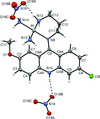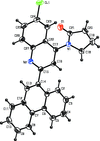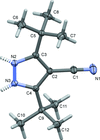issue contents
April 2016 issue

Cover illustration: In the crystal of (25R)-3![[beta]](/logos/entities/beta_rmgif.gif) ,16
,16![[beta]](/logos/entities/beta_rmgif.gif) -Diacetoxy-23-acetyl-22,26-epoxycholesta-5,22-diene n-hexane 0.8-solvate, the disordered n-hexane solvent of crystallization is agglomerated in channels oriented parallel to [100]. The steroid presents a conformation almost identical to that of its previously characterized benzene monosolvate. See: Hernández Linares, Carrasco-Carballo, Guerrero-Luna, Bernès & Aguirre Hernández [IUCrData (2016). 1, x160622].
-Diacetoxy-23-acetyl-22,26-epoxycholesta-5,22-diene n-hexane 0.8-solvate, the disordered n-hexane solvent of crystallization is agglomerated in channels oriented parallel to [100]. The steroid presents a conformation almost identical to that of its previously characterized benzene monosolvate. See: Hernández Linares, Carrasco-Carballo, Guerrero-Luna, Bernès & Aguirre Hernández [IUCrData (2016). 1, x160622].
metal-organic compounds
Download citation


Download citation


Open  access
access
 access
accessThe palladium(II) ion lies on a center of symmetry, chelating by the two bidentate Schiff base ligands in a trans-square-planar geometry. The complex has almost coplanar atoms with exception of the hexyl chains.
CCDC reference: 1403856
Download citation


Download citation


Open  access
access
 access
accessIn title complex salt, the secondary amine of 9-aminoacridine coordinates with platinum(II), leading to imine–platinum complex cation formation, proton rearrangement, and strained 9,10-dihydroacridin-9-imine formation.
CCDC reference: 1469909
Download citation


Download citation


Open  access
access
 access
accessThe molecules of the title compound form crosswise chains by C≡C—H⋯π interactions.
CCDC reference: 1472572
Download citation


Download citation


Open  access
access
 access
accessThe structure of the title complex determined at 296 K has a disordered methyl group in one valine ligand, a feature which was not observed in the structures previously reported at low temperatures.
CCDC reference: 1471474
Download citation


Download citation


Open  access
access
 access
accessDi(pyridin-2-yl)amine (dpa) ligands chelate ZnII ions to form [Zn(dpa)]2+ units, and these units are connected by the muconate ligands, forming chains. The solvate water molecules are connected to these chains through hydrogen bonds, forming a two-dimensional network.
CCDC reference: 1474269
Download citation


Download citation


Open  access
access
 access
accessThe new ionic compound [Na2(THF)4(μ-THF)(μ-DMF)2]2+[Fe2(S2C6H2Cl2)4]2− was synthesized and the crystal structure was solved by X-ray diffraction, showing that in the cation, tetrahydrofuran and dimethylformamide act as bridging molecules.
CCDC reference: 1474454
Download citation


Download citation


Open  access
access
 access
accessIn the title complex, the PdII atom is tetracoordinated in a square-planar coordination geometry. In the crystal, molecules are linked by pairs of C—H⋯Cl hydrogen bonds, forming inversion dimers.
CCDC reference: 1476177
organic compounds
Download citation


Download citation


Open  access
access
 access
accessIn the title compound, the quinoline nucleus is substituted by one chlorine, one phenanthrene, and one pyrrolidinone.
CCDC reference: 1471078
Download citation


Download citation


Open  access
access
 access
accessThe title molecule is built up from fused six- and seven-membered rings with a p-toluenesulfonyl group as a substituent.
CCDC reference: 1465135
Download citation


Download citation


Open  access
access
 access
accessIn the crystal of the title compound, inversion dimers are formed through pairs of N—H⋯S hydrogen bonds. These units are further are linked by C—H⋯O and C—H⋯N hydrogen bonds, forming slabs parallel to (001).
CCDC reference: 1471195
Download citation


Download citation


Open  access
access
 access
accessIn the crystal structure of the title compound, N—H⋯N hydrogen bonds form sheets parallel to (010).
CCDC reference: 1470245
Download citation


Download citation


Open  access
access
 access
accessIn the crystal, supramolecular layers propagating in the ac plane are formed via C—H⋯O hydrogen bonds.
CCDC reference: 1471582
Download citation


Download citation


Open  access
access
 access
accessIn the title compound, a luminescent chemosensor for the selective detection of Fe3+, the quinoline ring is inclined to the pyrene ring by 30.62 (5)°. In the crystal, molecules are linked by pairs of C—H⋯O hydrogen bonds forming inversion dimers, with an  (14) ring motif, flanked by two
(14) ring motif, flanked by two  (7) ring motifs.
(7) ring motifs.
CCDC reference: 1471583
Download citation


Download citation


Open  access
access
 access
accessThe title compound crystallizes with two independent molecules in the asymmetric unit. The two molecules have the same conformation and are linked via two N—H⋯O hydrogen bonds, forming dimers with an  (8) loop.
(8) loop.
CCDC reference: 1471952
Download citation


Download citation


Open  access
access
 access
accessThe phenyl ring is almost perpendicular to the mean plane through the indoline ring system. The molecules are linked by C—H⋯O hydrogen bonds and by π–π interactions.
CCDC reference: 1472134
Download citation


Download citation


Open  access
access
 access
accessThe sterically bulky diisopropyl aniline has been successfully condensed on pyrene-4,5,9,10-tetraone and the resulting tetraimine structurally characterized.
CCDC reference: 1470114
Download citation


Download citation


Open  access
access
 access
accessThe compound contains the dihydrobenzofuran moiety, which is present in the physiologically active components of many medicinal plants. In the crystal, there are weak intermolecular C—H⋯Br interactions.
CCDC reference: 1470708
Download citation


Download citation


Open  access
access
 access
accessIn the title compound, the imidazole ring forms dihedral angles of 9.2 (2), 10.9 (2) and 12.5 (2)° with the thiophene, phenyl and methoxy-substituted benzene rings, respectively. There are two intramolecular C—H⋯N hydrogen bonds forming S(5) and S(6) rings and one intramolecular C—H⋯O hydrogen bond forming an S(6) ring.
CCDC reference: 1472471
Download citation


Download citation


Open  access
access
 access
accessIn the title compound, the indole, naphthalene and benzoyl rings are inclined to the central pyrrole ring by 29.09 (9), 49.92 (9) and 45.95 (12) °, respectively. In the crystal, pairs of N—H⋯O and N—H⋯N hydrogen bonds link the molecules to form chains along [101], enclosing  (10) and
(10) and  (16) ring motifs.
(16) ring motifs.
CCDC reference: 1471048
Download citation


Download citation


Open  access
access
 access
accessThe pyridine and phenyl rings are inclined by 50.47 (2)°. The hydroxyl group is coplanar with the phenyl ring. In the crystal, pairs of C—H⋯O hydrogen bonds form  (10) ring motifs.
(10) ring motifs.
CCDC reference: 1471050
Download citation


Download citation


Open  access
access
 access
accessThe nitro substituent is nearly coplanar with the indazolyl moiety, while the ethyl group is twisted well out of the latter plane. Globally, the molecules pack in layers parallel to the ab plane.
CCDC reference: 1472479
Download citation


Download citation


Open  access
access
 access
accessThe title compound, is a combined product of 2,6-dihydroxybenzene and tetradecanal. It was isolated from the Indian spice Myristica malabarica and is a key pharmacophore against the protozoan parasitic disease Leishmaniasis.
CCDC reference: 1426062
Download citation


Download citation


Open  access
access
 access
accessThe title compound contains a fused ring system and a carbothioamide group as a substituent on the pyrazolidine ring. The mean planes of the two fused six- and five-membered rings are inclined to one another by 20.35 (6)°. In the crystal, molecules are linked by N—H⋯N and N—H⋯S hydrogen bonds, forming chains running parallel to [100].
CCDC reference: 1472696
Download citation


Download citation


Open  access
access
 access
accessThe packing in the title compound is consolidated by C—H⋯O and π-π interactions.
CCDC reference: 1472955
Download citation


Download citation


Open  access
access
 access
accessIn the crystal, N—H⋯N hydrogen bonds involving the indole NH group and the cyanide nitrogen atom lead to the formation of a two-dimensional supramolecular network lying parallel to (011).
CCDC reference: 1472998
Download citation


Download citation


Open  access
access
 access
accessIn the 1:1 adduct, C9H7N·C7H7NO2, the carboxyl group is twisted at an angle of 5.42 (8) Å with respect to its attached benzene ring. In the crystal, the carboxylic acid molecule is linked to the quinoline molecule by an O—H⋯N hydrogen bond. The 4-aminobenzoic acid molecules are linked by N—H⋯O hydrogen bonds, forming sheets propagating in (001).
CCDC reference: 1473449
Download citation


Download citation


Open  access
access
 access
accessThe crystal and molecular structure of the coumarin derivative 7-hydroxy-4-(hydroxymethyl)coumarin is reported. In the crystal, two classical O—H⋯O hydrogen bonds generate an extensive three-dimensional network structure.
CCDC reference: 1473298
Download citation


Download citation


Open  access
access
 access
accessIn the title compound, the side chain (including the Br atom) has a trans–gauche conformation. In the crystal, molecules are linked by weak C—H⋯O hydrogen bonds, forming a three-dimensional network.
CCDC reference: 1473227
Download citation


Download citation


Open  access
access
 access
accessThe title compound crystallizes with three sulfamerazine molecules and three tetrahydrofuran solvent molecules in the asymmetric unit.
CCDC reference: 1473264
Download citation


Download citation


Open  access
access
 access
accessThe indole unit is essentially coplanar and the dihedral angles between the central pyrrole ring and the pendant indole ring system and the nitrobenzene ring are 44.1 (2) and 51.3 (2)°, respectively.
CCDC reference: 1473319
Download citation


Download citation


Open  access
access
 access
accessThe title compound, synthesized by the condensation reaction of 2-methyl-4,6-diphenylaniline and acenaphthylene-1,2-dione, crystallizes with two independent molecules in the asymmetric unit. The two molecules differ essentially in the orientation of the phenyl ring at position 3′ of the terphenyl group with respect to the central ring of this unit. In molecule A this dihedral angle is 16.68 (14)°, while in molecule B the corresponding angle is 33.10 (16) °.
CCDC reference: 1473249
Download citation


Download citation


Open  access
access
 access
accessImidazole derivatives are heterocyclic compounds with important pharmacological activities. Ethyl 2-(2-methyl-4-nitro-1H-imidazol-1-yl)acetate is a new derivative.
CCDC reference: 1473028
Download citation


Download citation


Open  access
access
 access
accessIn the title compound, the plane of the propyl group is arched over the almost planar nine-membered fused-ring system [maximum deviation = 0.0202 (17) Å], making a dihedral angle of 71.97 (17)°.
CCDC reference: 1473515
Download citation


Download citation


Open  access
access
 access
access1,3-Dibromo-2-methyl-5-nitrobenzene crystallizes with two independent molecules in the asymmetric unit. In one molecule, the Br atoms lie almost in the plane of the benzene ring and the methyl C atom has a deviation of 0.038 (4) Å. In the other molecule, the opposite is observed.
CCDC reference: 1473718
Download citation


Download citation


Open  access
access
 access
accessIn the molecule, the butyl group adopts an extended conformation and the dioxaborolane ring has a twisted conformation on the C—C bond. In the crystal, there are no significant intermolecular interactions present.
CCDC reference: 1473545
Download citation


Download citation


Open  access
access
 access
access1,2,3,3-Tetramethyl-7-nitro-3,4-dihydroisoquinolinium tetrafluoroborate was prepared by methylation methods and its crystal structure determined. The crystal packing is governed by means of weak C—H⋯F contacts, which lead to the formation of a three-dimensional network.
CCDC reference: 1473672
Download citation


Download citation


Open  access
access
 access
accessThe molecule of the title compound is U shaped with the central C—S—N—C segment having a torsion angle of 63.2 (4)°. The crystal structure features strong N—H⋯O hydrogen bonds that form infinite [100] C(4) chains. Molecules in adjacent chains are interlinked via C—H⋯O, forming C(7) chains and resulting in a two-dimensional network in the ab plane; adjacent networks are connected by short Br⋯Br contacts, so that a three-dimensional supramolecular architecture ensues.
CCDC reference: 1474176
Download citation


Download citation


Open  access
access
 access
accessThe title solvate has the disordered n-hexane solvent distributed in channels oriented parallel to [100].
CCDC reference: 1473880
Download citation


Download citation


Open  access
access
 access
accessIn the crystal of trimethyl 3,3′,3′′-(benzene-1,3,5-triyl)tripropynoate, a system of new hydrogen-bond ring motifs involving C—H⋯O interactions give rise to the formation of layers of molecules, which are connected to each other via weak C—H⋯O and C—H⋯π contacts to complete the supramolecular packing structure.
CCDC reference: 1474004
Download citation


Download citation


Open  access
access
 access
accessIn the crystal, the N—H⋯N and N—H⋯S hydrogen bonds form chains of alternating cations and anions running parallel to the c axis.
CCDC reference: 1474600
Download citation


Download citation


Open  access
access
 access
accessIn the title compound, there is a weak intramolecular C—H⋯O contact which leads to a planar acrylamide moiety. The phenyl ring forms a dihedral angle of 8.30 (2)° with the mean plane of the acrylamide moiety. The benzyl group is inclined to the mean plane of the cinnamamide unit by 76.99 (2)°.
CCDC reference: 1474522
Download citation


Download citation


Open  access
access
 access
accessThe title compound is relatively planar with the mean plane of the but-3-en-2-one group and the ethoxy group making dihedral angles of 5.03 (8) and 5.37 (15)°, respectively, with the plane of the central benzene ring. In the crystal, molecules are linked by two pairs of C—H⋯O hydrogen bonds, forming inversion dimers.
CCDC reference: 1452611
Download citation


Download citation


Open  access
access
 access
accessIn the title molecule, the fused 1,4-thiazepinone ring adopts a near twist-boat conformation. In the crystal, molecules are linked by pairs of N—H⋯O hydrogen bonds, forming inversion dimers with an  (8) ring motif.
(8) ring motif.
CCDC reference: 1473503
Download citation


Download citation


Open  access
access
 access
accessIn the title compound, the phenyl ring is inclined to the almost planar (r.m.s. deviation = 0.027 Å) indoline ring system by 69.33 (7)°. In the crystal, molecules are linked by C—H⋯O hydrogen bonds.
CCDC reference: 1474205
Download citation


Download citation


Open  access
access
 access
accessThe benzodiazepin-2-one moiety of the title compound is substituted by a phenyl ring and a disordered ethyl group. In the crystal, molecules are linked by a pair of C—H⋯O hydrogen bonds, forming inversion dimers.
CCDC reference: 1474905
Download citation


Download citation


Open  access
access
 access
accessThe two independent zwitterions in the asymmetric unit are approximately planar. Intramolecular N—H⋯O hydrogen bonds occur and the aromatic rings have a trans configuration with respect to the azo double bond. In the crystal, the molecules are linked via N—H⋯O hydrogen bonds and π–π stacking, forming a three-dimensional supramolecular network
CCDC reference: 1474796
Download citation


Download citation


Open  access
access
 access
accessIn the crystal, a strong N—H⋯O hydrogen bond links the molecules, forming chains running along the c axis. The chains are linked by weak C—H⋯π interactions, forming layers parallel to the ac plane.
CCDC reference: 1474658
Download citation


Download citation


Open  access
access
 access
accessThe title compound represents the first symmetrically substituted 4-cyanopyrazole. The 4-cyano group lies in the plane of the pyrazole ring and has a linear C—C≡N bond angle of 179.2 (1)°. In the crystal, molecules are linked via N—H⋯N hydrogen bonds, forming inversion dimers with an  (6) ring motif.
(6) ring motif.
CCDC reference: 1475402
Download citation


Download citation


Open  access
access
 access
accessThere are two independent molecules in the asymmetric unit of the title compound that differ considerably in their conformations. Intramolecular O—H⋯N and intermolecular N—H⋯O hydrogen bonds are present. C—H⋯π interactions are also observed.
CCDC reference: 1474960
Download citation


Download citation


Open  access
access
 access
accessIn the title compound, the bicyclic triazolothiadiazole core is planar (r.m.s. deviation of 0.018 Å) and the phenyl rings are inclined to its mean plane by 7.66 (7) and 71.79 (7)°.
CCDC reference: 1473995
Download citation


Download citation


Open  access
access
 access
accessThe title compound has three independent molecules in the asymmetric unit which differ in the conformations of the substituents on the pyrazole ring. Extensive O—H⋯O, O—H⋯N, N—H⋯O and C—H⋯O hydrogen bonding is seen in the crystal.
CCDC reference: 1473996
Download citation


Download citation


Open  access
access
 access
accessThe conformation of the title molecule, is partially determined by an intramolecular N—H⋯O hydrogen bond, forming an S(6) loop, and an N—H⋯π interaction involving the centroid of the 4-chlorophenyl ring. In the crystal, molecules are linked by pairs of N—H⋯O hydrogen bonds, forming inversion dimers with an  (20) ring motif.
(20) ring motif.
CCDC reference: 1474779
Download citation


Download citation


Open  access
access
 access
accessThere is a short O—H⋯N contact in the molecule making an S(5) ring motif. In the crystal, there is a disordered and partially occupied ethan-1,2-diol solvent molecule present, located about an inversion centre, which links the title molecules via O—H⋯O and C—H⋯O hydrogen bonds, forming chains propagating along the a-axis direction.
CCDC reference: 1474273
Download citation


Download citation


Open  access
access
 access
accessIn the crystal, the title compound, C10H9FN4OS, forms a helical chain via an N—H⋯O hydrogen bond.
CCDC reference: 909982
Download citation


Download citation


Open  access
access
 access
accessIn the title compound, the phthalazine ring is fused with a cinnoline ring and their mean planes are inclined to one another by 46.56 (5)°. In the crystal, C—H⋯O hydrogen bonds link the molecules into chains along [010].
CCDC reference: 1476079
Download citation


Download citation


Open  access
access
 access
accessThe title compound has a planar structure (r.m.s. deviation = 0.062 Å). In the crystal, molecules are linked by N—H⋯O and C—H⋯O hydrogen bonds, forming layers parallel to the ab plane.
CCDC reference: 1476175
Download citation


Download citation


Open  access
access
 access
accessThe crystal structure of 4-chloro-1H-indole-2,3-dione is reported. In the crystal, N—H⋯O and C—H⋯Cl interactions are present.
CCDC reference: 1476174
Download citation


Download citation


Open  access
access
 access
accessIn the crystal, the molecules are linked by C—H⋯O hydrogen bonds, forming chains parallel to the b axis.
CCDC reference: 1476547
Download citation


Download citation


Open  access
access
 access
accessThe molecule of the title compound is planar (r.m.s deviation of 0.019 Å). In the crystal, molecules are linked by pairs of N—H⋯O hydrogen bonds, forming inversion dimers with an  (8) ring motif. The dimers are linked by I⋯O close contacts [3.078 (2) Å], forming chains along [10
(8) ring motif. The dimers are linked by I⋯O close contacts [3.078 (2) Å], forming chains along [10 ].
].
CCDC reference: 1476500
Download citation


Download citation


Open  access
access
 access
accessThe carbazole ring system of the title compound is planar with the ethyl substituent almost orthogonal to that plane. Weak halogen–carbon contacts are found in the crystal structure.
CCDC reference: 1476710
Download citation


Download citation


Open  access
access
 access
accessThe title compound was obtained in the course of the total syntheses of curvicollides A–C and features the same relative configuration for the central lactone moiety as that reported for the latter compounds. All of the OH groups act as donors as well as acceptors in O—H⋯O hydrogen bonds,hence each molecule is bound to six molecules and a three-dimensional network is formed.
CCDC reference: 1476414
Download citation


Download citation


Open  access
access
 access
accessThe molecular and crystal structures of 3-(4-chlorophenyl)-5-[−4-(methylsulfanyl)phenyl]-4,5-dihydro-1H-pyrazole are reported. In the crystal packing, N—H⋯N and C—H⋯Cl hydrogen bonds together with π–π stacking interactions contribute to the formation of a three-dimensional network.
CCDC reference: 1453871


 journal menu
journal menu









































































![[publCIF]](/logos/authorchecklist11.gif)





